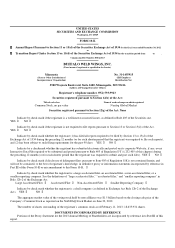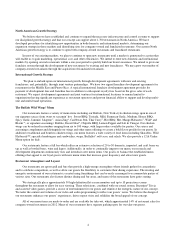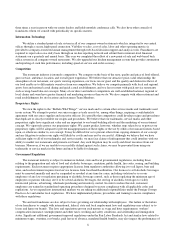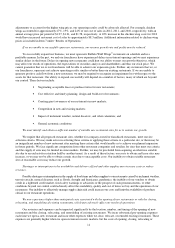Buffalo Wild Wings 2012 Annual Report Download - page 11
Download and view the complete annual report
Please find page 11 of the 2012 Buffalo Wild Wings annual report below. You can navigate through the pages in the report by either clicking on the pages listed below, or by using the keyword search tool below to find specific information within the annual report.11
adjustments to account for the higher wing prices, our operating results could be adversely affected. For example, chicken
wings accounted for approximately 27%, 19%, and 24% of our cost of sales in 2012, 2011, and 2010, respectively, with an
annual average price per pound of $1.97, $1.21, and $1.58, respectively. A 10% increase in the chicken wing costs for 2012
would have increased restaurant cost of sales by approximately $8.3 million. Additional information related to chicken wing
prices is included in Item 7 under “Results of Operations.”
If we are unable to successfully open new restaurants, our revenue growth rate and profits may be reduced.
To successfully expand our business, we must open new Buffalo Wild Wings
®
restaurants on schedule and in a
profitable manner. In the past, we and our franchisees have experienced delays in restaurant openings and we may experience
similar delays in the future. Delays in opening new restaurants could hurt our ability to meet our growth objectives, which
may affect our results of operations, the expectations of securities analysts and shareholders and thus our stock price. We
cannot guarantee that we or our franchisees will be able to achieve our expansion goals. Further, any restaurants that we, or
our franchisees, open may not achieve operating results similar or better than our existing restaurants. If we are unable to
generate positive cash flow from a new restaurant, we may be required to recognize an impairment loss with respect to the
assets for that restaurant. Our ability to expand successfully will depend on a number of factors, many of which are beyond
our control. These factors include:
• Negotiating acceptable lease or purchase terms for new restaurants;
• Cost effective and timely planning, design and build-out of restaurants;
• Creating guest awareness of our restaurants in new markets;
• Competition in new and existing markets;
• Impact of inclement weather, natural disasters, and other calamities; and
• General economic conditions.
We must identify and obtain a sufficient number of suitable new restaurant sites for us to sustain our growth.
We require that all proposed restaurant sites, whether for company-owned or franchised restaurants, meet our site
selection criteria. We may make errors in selecting these criteria or applying these criteria to a particular site, or there may be
an insignificant number of new restaurant sites meeting these criteria that would enable us to achieve our planned expansion
in future periods. We face significant competition from other restaurant companies and retailers for sites that meet our criteria
and the supply of sites may be limited in some markets. Further, we may be precluded from acquiring an otherwise suitable
site due to an exclusivity restriction held by another tenant. As a result of these factors, our costs to obtain and lease sites may
increase, or we may not be able to obtain certain sites due to unacceptable costs. Our inability to obtain suitable restaurant
sites at reasonable costs may reduce our growth.
Shortages or interruptions in the availability and delivery of food and other supplies may increase costs or reduce
revenues.
Possible shortages or interruptions in the supply of food items and other supplies to our restaurants caused by inclement weather,
terrorist attacks, natural disasters such as floods, drought and hurricanes, pandemics, the inability of our vendors to obtain
credit in a tightened credit market, food safety warnings or advisories or the prospect of such pronouncements, or other
conditions beyond our control could adversely affect the availability, quality and cost of items we buy and the operations of our
restaurants. Our inability to effectively manage supply chain risk could increase our costs and limit the availability of products
critical to our restaurant operations.
We may experience higher-than-anticipated costs associated with the opening of new restaurants or with the closing,
relocating, and remodeling of existing restaurants, which may adversely affect our results of operations.
Our revenues and expenses can be impacted significantly by the location, number, and timing of the opening of new
restaurants and the closing, relocating, and remodeling of existing restaurants. We incur substantial pre-opening expenses
each time we open a new restaurant and incur other expenses when we close, relocate, or remodel existing restaurants. These
expenses are generally higher when we open restaurants in new markets, but the costs of opening, closing, relocating or
























